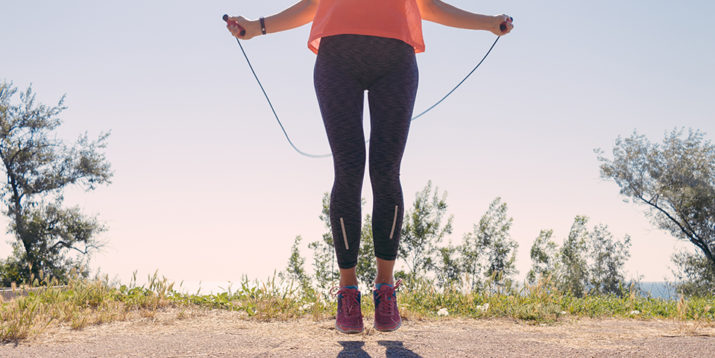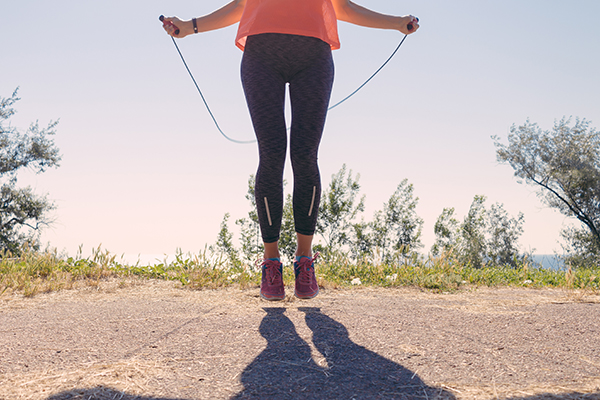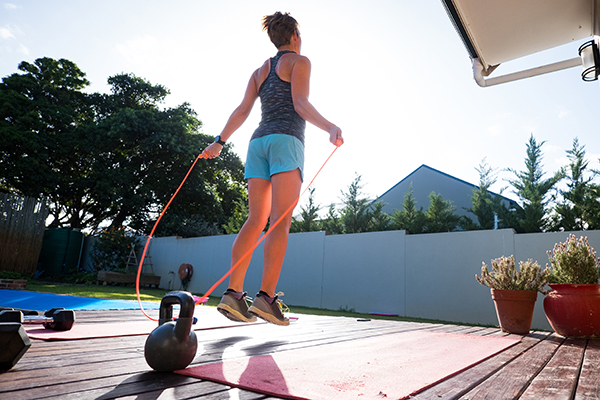The Benefits of a Jump Rope Workout

If you haven’t jumped rope since P.E. class in grade school, it might be time to give this exercise another try.
And if you think you’ve long forgotten how to jump rope, no worries.
It’s easy to master at any age — and jumping rope is an exercise that just about anyone can do with very little experience or equipment.
In minutes a day, a jump rope workout can help you burn calories, increase stamina, and boost power and cardiovascular fitness.
Even better? It works muscles from head to toe.
Jumping rope “primarily works your calves and forearms, but you will also get some good work in your quads and shoulders,” says Cody Braun, CPT, assistant manager of fitness at Beachbody.
“If you’re bored with your current cardio regimen, jumping rope can add a new skill to learn while elevating your heart rate for some good cardio work,” he adds.
Pro tip: Check out #mbf Muscle Burns Fat to learn how to incorporate jumping rope into your fitness plan.

Learn How to Jump Rope Correctly
You don’t need to learn fancy moves like double-unders and double Dutch to get in a good jump rope workout.
Start by mastering the basic jump, making sure you’re following these steps to keep your joints safe.
Think soft, fluid jumps — never stiff, cautions Braun.
- Hold the rope in both hands, with your elbows tucked in by your hips, palms facing out. Place the rope behind your feet to start.
- Bring the rope up behind you and over your head (the rotation should come from your wrists). Stay on the balls of your feet, keep your knees soft, and lift only a couple of inches off the ground.
- Maintain a strong core, and keep your chest up and gaze forward.
- Land softly with the rope behind your feet, and repeat.
If you’re just learning how to jump rope, aim for 30 seconds or a certain number of reps to start. Next time, do a few more reps or seconds than you did last time.
More advanced exercisers looking for jump rope cardio benefits can “try alternating tempos for 15 to 30 minutes,” says Braun.
Short on time? Try HIIT-style intervals at a faster tempo.
Or improve endurance and stamina with continuous reps for longer periods of time at a slow to moderate tempo.
Keep these pro tips in mind:
- “Pay attention to the time it takes between the sound of the rope hitting the floor and your feet touching the floor,” says Braun. Learning this timing will help your speed and rhythm, so you can complete more reps at a time.
- No rope? No problem. “You can still work on the movement by maintaining the same form and pace as if you had a jump rope,” explains Braun.
- Stay safe: “If you have joint issues or any other health concerns, always consult with your physician before diving into a new workout regimen,” Braun cautions. “Always make sure to keep your workout area clean and clear of all objects for safety, especially when you are swinging your jump rope.”

The Benefits of Jumping Rope
Jumping rope works the whole body. You can do it just about anywhere — making it ideal when you’re stuck indoors or lack access to a gym.
Check out all the benefits of jumping rope for your body — and even your mind!
1. It can burn more calories than jogging
If you’re a 150-pound person, you’d burn 136 calories jumping rope quickly for 10 minutes (or 90 calories if you jump slowly).
When you compare jump rope vs. running, jumping wins unless you’re speedy (7.5-minute miles or faster)!
Jogging burns 79 calories in 10 minutes while running at 8 mph burns 153 calories.
2. It’s great when you’re pressed for time.
Jump rope workouts are a good way to quickly feel the burn. “I like to use it to cap off a circuit to really increase the intensity of a training session,” says New Jersey personal trainer Nick Occhipinti, CPT, CSCS, MS.
You can even work up a sweat on your coffee break simply by jumping rope — try Tony Horton’s 10-Minute Jump Rope Workout.
3. It can help your coordination
Learning how to jump rope requires you to figure out how to make your hands and feet work together, which can help your coordination.
“If you want to work on your rhythm and tempo, you can play music, and time your hops to the beat,” suggests Braun.
4. It offers a mental boost
That coordination also forces the body and brain to cooperate, says Occhipinti. “Studies show that coordination and balance training improves cognition and slows the rate of cognitive decline in older populations,” he explains. “Long story short, activities that improve our coordination help our brains work smarter for longer.”
5. It can help you build power
“At its core, jumping rope is a high-impact plyometric exercise,” adds Occhipinti.
Jump training primarily targets your fast-twitch or type II muscle fibers and helps train a key athletic skill: explosiveness.
6. It helps keep your bones strong and healthy
“Every jump and land places a magnitude of our own body weight through the foot, ankle, knee, hip, and spine,” explains Occhipinti.
As a high-impact exercise, he says, jumping rope can help increase or maintain bone mineral density, which is crucial to maintaining strong and healthy bones.
7. It can help with cross-training
The general endurance and stamina you build from jumping rope can help you with any activity or sport.
But it’s especially helpful for athletes who require rhythm (think: boxing, rowing, and even running), says Braun.
“You can benefit from cross-training with workouts that utilize similar skills, such as jumping rope,” he says.
Types of Jump Rope
You can find several types of jump ropes online and at most major sporting goods stores.
(Please note, due to COVID-19, products may be sold out or more difficult to find.)
Make sure you read the fine print to make sure the one you choose is the right length for your height.
Cordless jump ropes
When you’re short on space or sharing equipment with someone who’s not the same height as you, cordless ropes are a good choice.
These are actually not ropes at all — only handles, sometimes with ball-shaped weights on the end.
They’re good for beginners, as well as anyone who’s challenged when it comes to coordination!
Try: Power Systems Airope Pro Weighted Jump Rope Alternative
Beaded jump ropes
Beaded jump ropes make that familiar slapping noise you may remember from childhood.
The beads can help prevent annoying tangles, and the sound they make can help you keep pace. (Not the best choice if you have downstairs neighbors!)
Try: Amble Jump Rope Soft Beaded Segment Jump Rope
Weighted jump ropes
These ropes have added weights in the handles to work your arms and shoulders. It’s harder to work on speed due to the added weight, but they’re good for beginners working on form, since they slow you down.
Try: Champion Sports Weighted Jump Rope
Speed jump ropes
Working to perfect your double-under, or trying to beat your own record for number of jumps per minute?
Pick up a speed rope, made with a thin, lightweight cord. Be careful: These can sting if you slap yourself with one!
